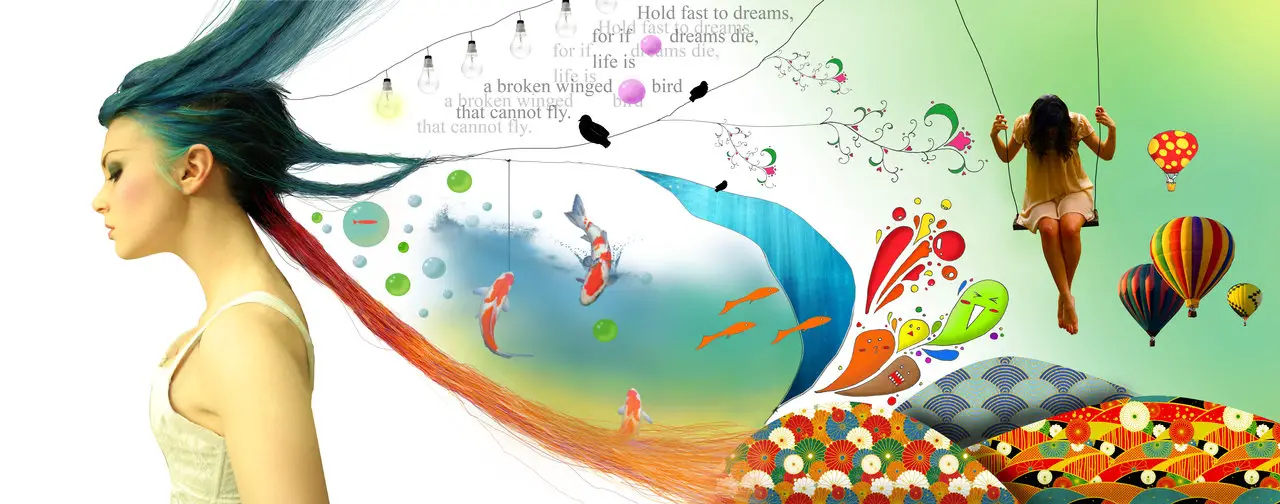Contributing writer for Wake Up World
“Hold fast to dreams, for if dreams die, life is a broken-winged bird that cannot fly.” ~ Langston Hughes
When we daydream we can lose ourselves in a self-generated flow of consciousness. We can do anything, go anywhere within the privacy of our minds. It is a means to escape the outer world, to face our fears, to entertain ourselves, and to explore our inner world, ideas, and scenarios. But those who like to indulge in reverie are often negatively labelled dreamers, dawdlers, or space cadets.
When we consider that we live in a consumer based, economically driven world that worships productivity and efficiency, it is no wonder that daydreaming has long been portrayed in a negative light. Daydreaming, the act of allowing our thoughts to flow spontaneously without an agenda or particular destination, is generally seen as a lazy habit, a waste of time and a distraction from the things that really matter. Sigmund Freud declared daydreaming to be a sign of mental illness, a neurotic and infantile tendency indulged in by those who were unfulfilled. However, more recent research is suggesting that daydreaming has many important benefits that have long been overlooked.
[pro_ad_display_adzone id=”110028″]
One of the important matters to come to light is that though daydreaming generally encourages a relaxed state of mind, when we float down our inner stream of consciousness our brains actually become highly stimulated, with many areas, including the pre-frontal lobe and executive centre becoming active. According to Marcus Raichle, a neurologist and radiologist at Washington University, “When you don’t use a muscle, that muscle really isn’t doing much of anything… But when your brain is supposedly doing nothing and daydreaming, it’s really doing a tremendous amount. We call it ‘resting state,’ but the brain isn’t resting at all.”
Some of the notable benefits of daydreaming that research has explored include:
Enhanced Memory
Likely to the surprise of many, a recent study published in Psychological Science by researchers from the University of Wisconsin and the Max Planck Institute for Human Cognitive and Brain Science found a correlation between daydreaming and an enhanced degree of working memory. Working memory is defined by cognitive scientists as the brain’s ability to retain and recall information when distractions are present. The study found that participants who more often indulged in daydreaming demonstrated a better ability to remember a series of letters when distracted by mathematical problems than those who were less inclined to daydream.
It would appear that daydreaming helps develop and maintain the neural networks that assist memory. So, though daydreaming during a lecture may not be the best way to succeed on a test, daydreaming in the right context could ultimately be beneficial.
Empathy
Research published in Psychological Bulletin suggests that people who more frequently indulge in daydreaming are more likely to have higher levels of empathy. Researchers observing a group of Israeli high school students found that students with high scores on the daydreaming scale demonstrated more empathy than students who scored low on the scale.
This makes sense when we consider how daydreaming allows us to explore different scenarios from different perspectives. The better our ability to imagine being in another person’s shoes, the more likely we will be able to understand their position.
Increased Creativity and Problem Solving Ability
In a study published in Psychological Science, led by Benjamin Baird and Jonathan Schooler at the University of California at Santa Barbara, the team found a correlation between participants daydreaming and creative problem-solving skills. In the study, participants were asked to come up with as many alternative uses for common objects. Researchers created two scenarios, one that encouraged people to daydream and one that didn’t. The people in the daydreaming group were found to be more likely to have higher scores than those in the group without the opportunity to daydream.
When we consider how daydreaming can encourage our brains to produce the relaxed alpha brainwaves that promote creative thought patterns it makes sense that the ability to generate a free flowing stream of consciousness assists us to access the deeper creative levels.
“He does not need opium. He has the gift of reverie.” ~ Anaïs Nin
Incubation
According to Scott Barry Kaufman, NYU psychology professor and author of ‘Ungifted: Intelligence Redefined’, daydreaming is a way to access our unconscious. One way daydreaming can do this is by providing our minds with valuable down-time, which provides the space for unconscious information to surface. Often when we return to a task after a short period of daydreaming we will find that answers that eluded us only moments before suddenly appear clear and obvious. Indeed, many of us would have noticed that it is often when our brains are occupied with non-demanding tasks that elusive answers pop up into our awareness. I’m sure nearly all of us have experienced a time when we were actively searching our minds, trying to remember the name of something, then later, after having given up, when we’re doing something completely unrelated, like engaging in relaxed daydreaming, the name we were looking for suddenly surfaces.
I suspect that many of the benefits of daydreaming have to do with its ability to help connect us to our unconscious. The unconscious is like our own personal super computer. While our conscious memories are limited, our unconscious records everything we come into contact with. It is the place of genius and inspiration where our deeper self resides. Because daydreaming uses the inherent language of the subconscious mind (imagery, metaphors and feeling), it allows us to both receive and communicate valuable information in a way that the subconscious mind can understand. The more vivid and detailed the day dream is, the more parts of the brain will be involved in the process, which helps to build new synapses in the brain and positively affects our ability to see from different perspectives and uncover solutions.
Focus
It is interesting to note that both daydreaming, which is using the mind to distance ourselves from the present moment and external reality, and mindfulness which is about immersing ourselves in the present moment of our external reality, contribute to healthy functioning and wellbeing because the better we get at both the better we become at filtering out distraction.
“Television is simply automated daydreaming.” ~ Lee Loevinger
Because today so much of our world is automated, and we are constantly flooded with external distraction, I believe the ability to daydream is even more important than ever. Today it is so easy for us to turn to our phones to fill in the blank periods of boredom that we used to fill with daydreams. In a culture obsessed with busyness and goals indulging in a bit of free-flowing, internally generated imagery can undoubtedly contribute to a balanced, healthy lifestyle. The important things to remember when daydreaming are to keep the content constructive and positive, and to practice in the right time and place.
“Reverie is not a mind vacuum. It is rather the gift of an hour which knows the plenitude of the soul.” Gaston Bachelard
Article references:
- www.dujs.dartmouth.edu/2011/02/science-of-daydreaming
- www.psychologicalscience.org/index.php/news/daydreaming-boosts-creativity-study-suggests.html
- www.bachelorsdegreeonline.com/blog/2012/the-scientifically-proven-benefits-of-daydreaming
- www.opencolleges.edu.au/informed/features/15-reasons-why-daydreamers-are-better-learners
About the author:
Christina Lavers is a writer, an artist, a creative enthusiast, and an inner world explorer. Born in Montreal Quebec, Canada, she now lives with her life partner and son in a rainforest pocket in the hills behind Coffs Harbour, NSW Australia. She spends her time playing, creating, growing and sharing.
Christina is devoted to assisting people to find and connect with their own creative magical current that flows deep within. She is now offering a comprehensive e-course designed to help people light up their world with passion and creativity. You can access Section One here for free! (This course has recently been updated. Check out the striking new look here.)
Christina has also recently published her first full length book, a memoir about her wild awakening journey entitled Jump Into the Blue, and she is currently working on the next one.
“My journey has been about personal alchemy… exploring the mysteries of my soul and my environment, and learning to bring all aspects, the light and the dark, together with the transcending ingredient… love. The more I uncover and nurture the wounded aspects of my being, the more whole and grounded I feel and the more my outer world reflects the love, wonder and magic I have discovered inside”.
You can follow Christina’s work at:
Recommended reading by Christina Lavers:
- Decline in Childhood Play Related to Rising Anxiety and Depression in Children, Adolescents
- Are You a Bridge Between Two Worlds?
- Addictive Behavior Related to Low Levels of Oxytocin, the “Love/Bonding Hormone”
- 10 Signs You’ve Bought Spin
- New Study Shows Regular Contact with Nature Reduces Crime, Increases Social Cohesion
- Sugar is as Addictive as Cocaine – Here’s How You Can Kick the Habit
- Research Shows Just 7 Minutes of Meditation Can Reduce Racial Prejudice
- Taking Care of Our Inner Tribes – Microflora, Awakening and You
- Groundbreaking Study Maps the Decline of Wild Bee Communities in the United States
- Taking Responsibility For Our Energy
- More Evidence That TV is Dumbing Us Down
- Synchrony and Exertion of Dancing Found to Encourage Social Bonding, Raise Pain Threshold
- Quitting Smoking? Try These Herbs, Tips and Incentives to Help You Succeed!
- Dream On! Lucid Dreaming Improves Self Awareness and Metacognition
[pro_ad_display_adzone id=”110027″]










